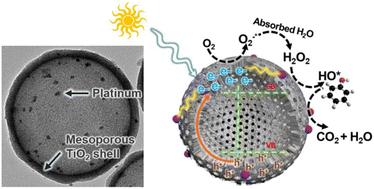当前位置:
X-MOL 学术
›
Environ. Sci.: Nano
›
论文详情
Our official English website, www.x-mol.net, welcomes your feedback! (Note: you will need to create a separate account there.)
Highly uniform platinum photodeposited hollow mesoporous titania nanoparticles for photocatalytic degradation of phenol
Environmental Science: Nano ( IF 5.8 ) Pub Date : 2024-06-19 , DOI: 10.1039/d4en00156g Dauletkerey Kudaibergen 1 , Geun Young Kim 1 , Hyun-Seok Choe 1 , Jeong-Min Park 1 , Han-Gil Kim 1 , Donghyun Lee 2 , Heewoo Jeon 2 , Changha Lee 2 , Jae-Hyuk Kim 1
Environmental Science: Nano ( IF 5.8 ) Pub Date : 2024-06-19 , DOI: 10.1039/d4en00156g Dauletkerey Kudaibergen 1 , Geun Young Kim 1 , Hyun-Seok Choe 1 , Jeong-Min Park 1 , Han-Gil Kim 1 , Donghyun Lee 2 , Heewoo Jeon 2 , Changha Lee 2 , Jae-Hyuk Kim 1
Affiliation

|
Photocatalysis is an essential and cost-effective method for efficient disinfection and profound detoxification of organic waste from wastewater. In this study, we fabricated an unprecedented facile Pt photodeposited crystalline hollow mesoporous titania nanoparticle (Pt/c-HMTN) module and investigated its photocatalytic efficiency to decompose phenol as a target compound in an aqueous phase. Pt/c-HMTN was produced by a hard template method using silica as a hydrothermally etchable template prior to the facile decoration of the mesoporous titania shell through a modified sol–gel method. Crystallization at 720 °C was performed, followed by Pt photodeposition. The size of Pt/c-HMTN was confirmed to be around 450–500 nm. Comparative experiments between Pt/c-HMTN and c-HMTN exhibited 1.42-fold excellent photocatalytic performance of Pt/c-HMTN compared to c-HMTN, where kc-HMTN = 0.01946 s−1 and kPt/c-HMTN = 0.04458 s−1, an almost 4-fold difference in kinetics. Quantitative analysis regarding catalyst dosage, pH, and temperature was provided additionally. pH revealed the most prominent influence (40% increase in photocatalytic performance, kpH10 = 0.03400 s−1 vs. kpH7 = 0.01058 s−1) caused by an abundance of hydroxyl radicals at pH 10, whereas temperature variation showed a negligible difference in photocatalytic activity. Furthermore, we have conducted scavenger and stability tests, which included oxidative free radical and hole-trapping tests to investigate a predominant pathway responsible for phenol degradation and the reusability of the catalyst module under continuous pollutant input, respectively. We also elucidated the plausible mechanism of the radical pathway and the role of Pt nanoclusters supported on faceted c-HMTN in photocatalysis. The reaction intermediates have been analyzed and detailed descriptions have been added to provide an overall understanding of the pathway. The samples were characterized using XRD, SEM, TEM, BET, and HPLC to identify the remaining contaminant in the system. In summary, we assure that the Pt/c-HMTN module can be effectively applied in organic contaminant decomposition owing to its superiority in photocatalytic efficiency and reusability.
中文翻译:

高度均匀的铂光沉积空心介孔二氧化钛纳米粒子用于光催化降解苯酚
光催化是对废水中的有机废物进行高效消毒和深度解毒的一种重要且经济高效的方法。在这项研究中,我们制造了一种前所未有的简便的Pt光沉积结晶中空介孔二氧化钛纳米颗粒(Pt/c-HMTN)模块,并研究了其在水相中分解苯酚作为目标化合物的光催化效率。 Pt/c-HMTN 是通过硬模板法生产的,使用二氧化硅作为水热可蚀刻模板,然后通过改进的溶胶-凝胶方法轻松装饰介孔二氧化钛壳。在 720 °C 下进行结晶,然后进行 Pt 光沉积。 Pt/c-HMTN 的尺寸被证实约为 450-500 nm。 Pt/c-HMTN与c-HMTN的对比实验显示,Pt/c-HMTN的光催化性能是c-HMTN的1.42倍,其中k c-HMTN = 0.01946 s −1 k Pt/c-HMTN = 0.04458 s −1 ,动力学上几乎有 4 倍的差异。另外还提供了有关催化剂用量、pH 值和温度的定量分析。 pH 值显示出最显着的影响(光催化性能提高 40%,k pH10 = 0.03400 s −1 vs. k pH7 = 0.01058 s −1
更新日期:2024-06-19
中文翻译:

高度均匀的铂光沉积空心介孔二氧化钛纳米粒子用于光催化降解苯酚
光催化是对废水中的有机废物进行高效消毒和深度解毒的一种重要且经济高效的方法。在这项研究中,我们制造了一种前所未有的简便的Pt光沉积结晶中空介孔二氧化钛纳米颗粒(Pt/c-HMTN)模块,并研究了其在水相中分解苯酚作为目标化合物的光催化效率。 Pt/c-HMTN 是通过硬模板法生产的,使用二氧化硅作为水热可蚀刻模板,然后通过改进的溶胶-凝胶方法轻松装饰介孔二氧化钛壳。在 720 °C 下进行结晶,然后进行 Pt 光沉积。 Pt/c-HMTN 的尺寸被证实约为 450-500 nm。 Pt/c-HMTN与c-HMTN的对比实验显示,Pt/c-HMTN的光催化性能是c-HMTN的1.42倍,其中k c-HMTN = 0.01946 s −1 k Pt/c-HMTN = 0.04458 s −1 ,动力学上几乎有 4 倍的差异。另外还提供了有关催化剂用量、pH 值和温度的定量分析。 pH 值显示出最显着的影响(光催化性能提高 40%,k pH10 = 0.03400 s −1 vs. k pH7 = 0.01058 s −1











































 京公网安备 11010802027423号
京公网安备 11010802027423号